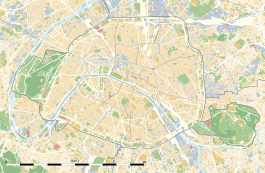The Rue Bleue is a street in the 9th arrondissement of Paris.
 | |
| Arrondissement | 9th |
|---|---|
| Quarter | Quartier du Faubourg-Montmartre |
| Coordinates | 48°52′33.633″N 2°20′41.113″E / 48.87600917°N 2.34475361°E |
| From | Rue du Faubourg-Poissonnière |
| To | Rue La Fayette |
Origin of the name
editIn February 1789, for the beautiful eyes of the Comtesse de Buffon, the Duke of Orléans (Philippe Égalité) had the name of the street changed by a decree of the King's Council (February 19, 1789): "The Rue d'Enfer will henceforth be called the Rue Bleue, a name which will be more easily remembered than any other, given that in the same district there is one which bears the name of Rue Verte" (not really nearby, however, since it was probably the current Rue de Penthièvre, in the 8th arrondissement).
Another source mentions that the route receives its current name after a factory of blue balls founded in this street in 1802.[1]
Notable places
edit- On the night of January 18 to 19, 1971, police officer François Costantini was shot dead at the corner of the Rue du Faubourg-Poissonnière by Félix Léandri, caught with two accomplices stealing Erast Bocancea's satchel.
- No. 1: practicing the profession of building caretaker there for a living, Cesare Battisti, a former member of an Italian terrorist organization who became a writer in France, lived for a long time at this address, on the sixth floor; it was in the lobby of the building that he was arrested on the morning of February 10, 2004, by police officers from the National Anti-Terrorist Division.[2]
- No. 2: Louis-Émile Vanderburch (1794-1862), successful playwright, lived at this address in the early 1840s.[3]
- No. 3: home, in 1899, of the chemist and balloonist Gaston Tissandier (1843-1899).[4]
- Nos. 5 and 7: between these numbers opens, on the south side of the street, the Cité Trévise.[5] As the city is partially listed as a historical monument, the facade and roof of 5, rue Bleue are also listed.
- No. 6: Émile Prudent (1817-1863), pianist, composer and music teacher, died there on May 13, 1863.[6]
- No. 9: The fashion school MOD'SPE Paris founded in 1993 has its main campus.[7]
- No. 12: Georges Henri Roger (1860-1946), doctor of medicine was born at 12 rue Bleue on June 4, 1860.[8]
- No. 14: the house is built on the site of a house where Charles-Henri Sanson, the executioner of King Louis XVI, was born.
- No. 17: house built with stones from houses demolished by the explosion in the Rue Saint-Nicaise, which threatened the life of the First Consul. General Taviel, Oberkampf, the widow of Hoche and her daughter Jenny Hoche, Comtesse des Roys, lived there. It is at this address that director Chad Chenouga places the home of Adda, his children and his sisters, the main characters of his first feature film, released in 2001, aptly titled 17, rue Bleue. Also at this address, at the end of the courtyard, is the House of Armenian Culture.
- No. 19: François Sudre (1787-1862), French musician and music teacher, known for having invented telephony and the universal musical language, then called Solresol, died there on October 3, 1862.
- No. 20: number deleted. The excavation of the section of the Rue de Trévise from the Rue Bleue to the Rue Lafayette caused the disappearance of a south-facing house which had been the home of Gustave and Jane Monod and the birthplace of their son Charles Monod (1843-1921). The family will then stay at 114, place Lafayette (place Franz-Liszt).[9]
- No. 25: the facade of the Leclaire house, house painting company, has a commemorative plaque in homage to Edme-Jean Leclaire (1801-1872) as well as his profile.
- No. 25: mortuary home of Admiral Delsaigne, who had taken and retaken Guadeloupe.
- At no. 27, the Belgian Maurice Braive and his wife, born Floriane de Bellaielgh, who had founded the Independent Group of High Esoteric Studies of Paris, were arrested in 1941 because of the acts contrary to good morals that they organized there. Police intervention which would also have been justified by the frequentation of the place by Alain de Bernardy de Sigoyer. This affair inspired Patrick Modiano with elements of his novel L'Horizon, published in 2010.
- No. 29: Henri-Laurent Rivière (1827-1883), man of letters and French naval officer, was born there on July 12, 1827.[10]
-
MOD'SPE Paris
-
Leclaire house
-
Leclaire house
References
edit- ^ Dictionnaire administratif et historique des rues de Paris et de ses monuments
- ^ Battisti sème la pagaille au conseil du IX e
- ^ Le Constitutionel
- ^ Kevin Desmond, Gustave Trouvé: French Electrical Genius (1839-1902), McFarland, 2015, p. 159.
- ^ Cité Trévise
- ^ Avis de décès d'Émile Prudent
- ^ MOD'SPE Paris
- ^ Acte de naissance de Georges Henri Roger
- ^ Rue de Trévise
- ^ Acte de naissance de Henri-Laurent Rivière
